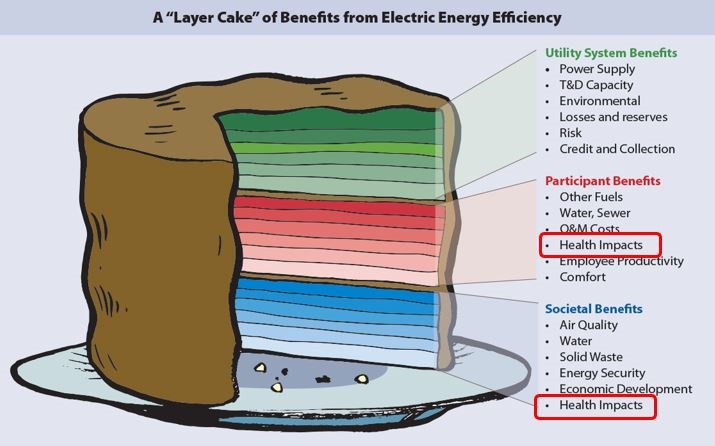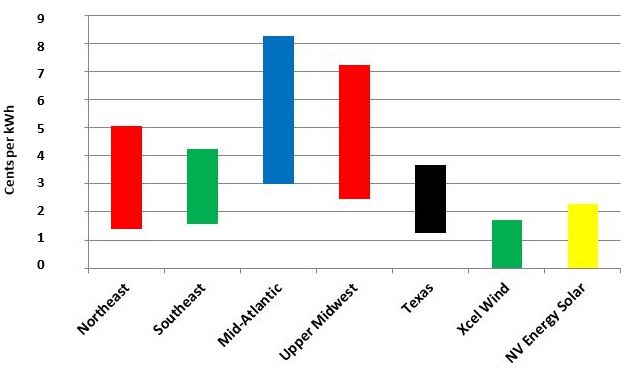In 2013, RAP released a pathbreaking publication, Recognizing the Full Value of Energy Efficiency. We refer to the main concept of this paper as “the layer cake,” after its centerpiece concept analogizing the multiple benefits of energy efficiency as layers in a cake. Health benefits, both for individual participants in an efficiency program and for society as a whole, were two of these layers.

The health benefits of reducing criteria pollutants — carbon monoxide, lead, nitrogen dioxide, ozone, particulate matter and sulfur dioxide — have been quantified in numerous studies and consistently show significant economic value. These benefits include lower rates of premature deaths, nonfatal heart attacks, asthma exacerbations and other respiratory diseases. However, placing a value on the ability of energy efficiency and renewable energy to reduce these pollutants has been more technically challenging — so most cost-effectiveness analyses leave it out. The result is that energy planning typically values it at zero.
But a new tool from the U.S. Environmental Protection Agency (EPA) has changed that.
In August, the EPA published Estimating the Health Benefits per-Kilowatt Hour of Energy Efficiency and Renewable Energy, which contains regionally specific estimates of the per-kWh value of societal health benefits from multiple types of efficiency and renewable energy resources. This is a first: Where the “layer cake” provided a clear placeholder for these values, now we have well-researched numbers to plug in.
The results are dramatic. The health benefits gained from installing wind and solar may exceed the entire cost of these new clean energy resources, while energy efficiency continues to demonstrate why it is the “first fuel” resource. The graphic below shows the range of per-kWh benefits the EPA identified across selected regions, compared with the amounts two specific utilities (Xcel and NV Energy) are paying per kWh for new wind and solar resources.

What does this new information mean for states and utilities?
First, they should include these values in evaluating the cost-effectiveness of new energy efficiency programs and measures and comparing the costs of operating existing fossil-fired generation versus the costs of new renewable generation.
Second, states can use the EPA’s values to review emissions control options in their federal plans for ozone nonattainment, regional haze and reducing the critical health impacts of fine particulate matter. For example, a state could consider how the costs of additional efficiency programs compare to adding control measures to the existing fossil-fueled fleet or examine whether retiring existing generation is the most cost-effective way to meet EPA deadlines for ozone public health standards. This is the responsibility of air quality regulators, and they need to communicate this information to utility regulators.
The tool does not include the climate benefits from reduction in carbon dioxide (CO2) emissions. Those benefits will come alongside the quantifiable health benefits of energy efficiency and renewables as fossil fuel use is reduced. State utility regulators in states that regulate CO2 emissions can calculate the value of CO2 reduction separately and ensure that this value is included in resource planning and dispatch methods.
RAP is developing a policy brief that will explore this development in much greater detail, including:
- A deeper dive into the EPA’s methodology and regional variations in the data.
- Issues to consider when incorporating these values into energy efficiency and renewable energy valuations.
- More detailed recommendations on how regulators can use the EPA’s new tool.
For now, we can say this is a powerful new resource. It provides an easy and clear means to assess how fossil-fuel power plants harm public health. With that knowledge, regulators and others can more easily consider those health costs in evaluating power system resource options.
Our goal in writing Recognizing the Full Value of Energy Efficiency was, as we noted in the paper’s subtitle, to demonstrate “what’s under the feel-good frosting of the world’s most valuable layer cake of benefits.” Now we have a tool that quantifies the value of more of these layers — providing an even better recipe for baking the cake.

